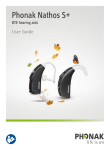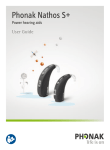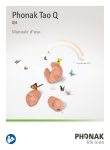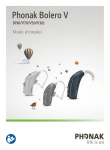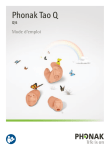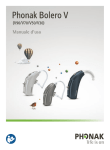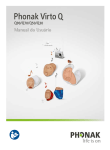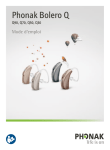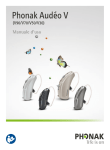Download User Guide - Phonak NHS
Transcript
ITE hearing aids User Guide Contents 1. Welcome5 2. Important safety information: Please read before operating your hearing aid for the first time 6 2.1 Hazard warnings 6 2.2 Information on product safety 9 3. Hearing aid description 12 4. Step-by-step instructions for using the hearing aid 15 2 Step 1. Getting to know your hearing aid 15 Step 2. Battery preparation 18 Step 3. Inserting the battery 18 Step 4. Turning on the hearing aid 19 Step 5. Inserting the hearing aid 20 Step 6. Adjusting the volume control in the ear 22 Step 7. Selecting the hearing program in the ear 24 Step 8. Removing the hearing aid 25 Step 9. Turning off the hearing aid 26 Step 10.Changing the battery 5. Care and maintenance 27 28 6. Troubleshooting31 7. Wireless accessories description 33 8. Service and warranty 37 9. Compliance information 38 10.Information and explanation of symbols 39 3 This user guide is valid for: Wireless models Phonak Nathos S+ ITC W Phonak Nathos S+ ITE W 4 CE mark applied 2014 2014 1.Welcome Your new hearing aid is a premium Swiss quality product. It was developed by Phonak, one of the world‘s leading companies in hearing technology. Your hearing aid offers the most modern digital hearing technology currently available on the market. Please read these user instructions thoroughly in order to benefit from all the possibilities your new hearing aid has to offer. With proper use and care, you will be able enjoy your hearing aid for many years to come. If you have any questions, please consult your hearing care professional. Phonak – life is on www.phonak.co.uk 5 2. Important safety information Please read the information on the following pages before using your hearing aid. A hearing aid will not restore normal hearing and will not prevent or improve a hearing impairment resulting from organic conditions. Infrequent use of a hearing aid does not permit a user to attain full benefit from it. The use of a hearing aid is only part of hearing habilitation and may need to be supplemented by auditory training and instruction in lipreading. 2.1Hazard warnings The intended use of hearing aids is to amplify and transmit sound to the ears and hereby compensate for impaired hearing. The hearing aids (specially programmed for each hearing loss) must only be used by the intended person. They should not be used by any other person as they could damage hearing. Changes or modifications to the hearing aid that were not explicitly approved by Phonak are not permitted. Such changes may damage your ear or the hearing aid. 6 Do not use the hearing aids in explosive areas (mines or industrial areas with danger of explosions). Hearing aid batteries are toxic if they are swallowed! Keep out of reach of children, mentally challenged people and pets. If batteries are swallowed, consult your physician immediately! If you feel pain in or behind your ear, if it is inflamed, if skin irritation or accelerated accumulations of ear wax occur, please check with your hearing care professional or physician. Hearing programs in the directional microphone mode reduce background noises. Please be aware that warning signals or noises coming from behind, e. g. cars, are partially or entirely suppressed. This hearing aid is not designed to be used for children below 36 months. The hearing aid contains small parts that can cause choking, if swallowed by children. Keep out of reach of children, mentally challenged people and pets. If swallowed, consult a physician or hospital immediately. 7 2. Important safety information External devices may only be connected if they have been tested in accordance with corresponding IECXXXXX standards. Only use accessories approved by Phonak AG, to avoid any electrical shock. The following is only applicable for persons with active implantable medical devices (i.e. pacemakers, defibrillators, etc.): ■ Keep the wireless hearing aid at least 15 cm (6 inches) away from the active implant. If you experience any interference, do not use the wireless hearing aids and contact the manufacturer of the active implant. Please, note that interference can also be caused by power lines, electrostatic discharge, airport metal detectors etc. ■ Keep magnets (i.e. battery handling tool, EasyPhone magnet, etc.) at least 15 cm (6 inches) away from the active implant. ■ You are not permitted to use wireless accessories for your hearing aids. Ask your hearing care professional for details. 8 2.2Information on product safety Never immerse your hearing aid in water! Protect it from excessive moisture. Always remove your hearing aid before showering, bathing, or swimming, as the hearing aid contains sensitive electronic parts. Protect your hearing aid from heat (never leave it near a window or in the car). Never use a microwave or other heating devices to dry your hearing aid. Ask your hearing care professional about suitable drying methods. When you are not using your hearing aid, leave the battery compartment open so that any moisture can evaporate. Make sure that you always completely dry your hearing aid after use. Store the hearing aid in a safe, dry and clean place. Do not drop your hearing aid! Dropping onto a hard surface can damage your hearing aid. 9 2. Important safety information Always use new batteries for your hearing aid. In case a battery is leaking, replace it immediately with a new one to avoid skin irritations. You can return used batteries to your hearing care professional. The batteries used in these hearing aids should not exceed 1.5 Volts. Please do not use silver-zinc or Li-ion (lithium-ion) rechargeable batteries as these may cause severe damage to your hearing aids. The table in chapter 3 explains exactly which type of battery your particular hearing aids require. Remove the battery if you are not using your hearing aid for a long period of time. 10 Special medical or dental examination including radiation described below, may adversely affect the correct functioning of your hearing aids. Remove and keep them outside the examination room/area before undergoing: SS Medical or dental examination with X-ray (also CT scan) SS Medical examinations with MRI/NMRI scans, generating magnetic fields Hearing aids don’t need to be removed when passing security gates (airports etc.). If X-ray is used at all, it will be in very low doses, and will not affect the hearing aids. Do not use your hearing aid in areas where electronic equipment is prohibited. 11 3. Hearing aid description The following user instructions describe different hearing aid models. Use the labeled drawings to identify the hearing aid that you use. Please note: specific functions described on the following pages may not be included in your model because some features are optional or model specific. The following table shows what battery you need for your hearing aid model. Model ITC W ITE W Zinc air battery size (marking on package) 312 (brown) 13 (orange) IEC code PR41 PR48 ANSI code 7002ZD 7000ZD Please ensure you use the correct type of battery in your hearing aids (zinc-air). Please also read chapter 2.2 for further information on product safety. 12 ITC W d c e f b a g h a Custom made shell b Receiver (sound outlet) and wax protection system c Battery compartment with ON/OFF switch d Protected microphone inlets e Program button (optional) f Right or left indicator (right=red, left=blue) g Volume control (optional) h Vent 13 3. Hearing aid description ITE W d c e f b a g h a Custom made shell b Receiver (sound outlet) and wax protection system c Battery compartment with ON/OFF switch d Protected microphone inlets e Program button (optional) f Right or left indicator (right=red, left=blue) g Volume control (optional) h Vent 14 4. Step-by-step instructions for using the hearing aid The following chapter provides step-by-step instructions on how to use your hearing aid. Please follow these steps carefully. In the drawings, the parts that are particularly important for each step are shown in green. Step 1. Getting to know your hearing aid Take the hearing aid in your hand and try out the hearing aid controls, if so equipped. This will make it easier for you to feel for and operate the controls later on when wearing the hearing aid. 15 4. Using the hearing aid Turn the volume control to change the volume (Fig. 1a). Right ear Left ear Louder Louder Softer Softer Fig. 1a The direction you have to turn the volume control when wearing the hearing aid in the ear is shown in step 6 in this section. 16 Your hearing care professional can configure the push button as either a volume control or a program selector. In order to change a hearing program or the volume, press the push button (Fig. 1b). Fig. 1b To increase the volume, press the button on your right hearing aid. To decrease the volume, press the button on your left hearing aid (Fig. 1c). Decrease volume Increase volume Left hearing aid Right hearing aid Fig. 1c 17 4. Using the hearing aid Step 2. Battery preparation Remove the protective foil from the new battery (Fig. 2). Wait for two minutes before inserting to activate the battery. Fig. 2 Step 3. Inserting the battery Take the hearing aid in your hand (Fig. 3a) and open the battery door. Insert the battery so that you see the + symbol on the battery (Fig. 3b). Fig. 3a 18 Fig. 3b Step 4. Turning on the hearing aid Switch on the hearing aid by closing the battery compartment (Fig. 4). Fig. 4 II Open and close the battery compartment gently and carefully. II If you feel resistance when closing the battery compartment, check to make sure the battery is correctly inserted and in the correct direction. If the battery is inserted the wrong way, the hearing aid will not work and the battery compartment can be damaged. The hearing aid is now switched on. It can take up to 15 seconds before it starts. (When you wear the hearing aid, you will hear an acoustic signal). 19 4. Using the hearing aid Step 5. Inserting the hearing aid This step shows you how to correctly insert the hearing aid. II Each hearing aid is individually programmed for your right or left ear. For the first step identify right and left so you will be able to insert your hearing aid in the correct ear. Step 5.1 Identifying the hearing aids for the right and left ear The color mark is located on the shell (the text is printed in red or blue, or the shell is colored red or blue): right = red left = blue Fig. 5a 20 Step 5.2 Inserting the hearing aid (all models) With your right hand, take your hearing aid for the right ear (marked in red, see step 5.1) between your thumb and forefinger (Fig. 5b). Insert the tip of the hearing aid into the ear canal (see the part circled in green in Fig. 5b). Carefully pull on your earlobe and push the hearing aid into the correct position. Ensure that it is positioned securely. In the beginning, please use a mirror to check. Fig. 5b 21 4. Using the hearing aid You have now successfully inserted the right hearing aid. Now insert your left hearing aid in the same way (marked in blue, see step 5.1) Step 6. Adjusting the volume control in the ear To increase the volume (possible only on models with an optional volume control), turn the volume control forward. To decrease it, turn the volume control backward using your forefinger (Fig. 6a). Left ear Right ear Louder Louder Softer Fig. 6a 22 Softer Your hearing care professional can configure the push button as either a volume control or a program selector. To increase the volume, press the button on your right hearing aid. To decrease the volume, press the button on your left hearing aid (Fig 6b). Decrease volume Increase volume Left hearing aid Right hearing aid Fig. 6b 23 4. Using the hearing aid Step 7. Selecting the hearing program in the ear To change a hearing program (possible only in models with an optional program button), press the program button shown (Fig. 7). Fig. 7 If you press it again, you change to the next program. A signal indicates the change. A signal tone can only be easily heard if you have turned on the hearing aid and you are wearing it correctly in the ear. 24 Step 8. Removing the hearing aid Put your thumb behind your lobe (directly behind the hard cartilage, Fig.8a) and gently press your ear upward to push the hearing aid out of the canal. In order to help it along, make chewing movements with your jaw. Fig. 8a Grasp the protruding hearing aid and remove it (Fig. 8b). Fig. 8b 25 4. Using the hearing aid Step 9. Turning off the hearing aid You can turn off your hearing aid by opening the battery compartment (Fig. 9) Fig. 9 26 Step 10. Changing the battery Your hearing aid will indicate with a double beep, that the battery soon needs to be changed. You typically have up to 30 minutes to change the battery, however this can differ and might be considerably shorter. We recommend that you always keep a spare battery on hand. 27 5. Care and maintenance Diligent and routine care of your hearing aid contributes to outstanding performance and a long service life. Please use the following specifications as a guideline: General information Before using hair spray or applying cosmetics, you should remove your hearing aid from your ear, because these products may damage it. 28 Daily Daily cleaning and the use of a drying system is highly recommended. “C&C line” from Phonak is a complete set of cleaning products. Your hearing care professional will be glad to advise you. Never use household cleaning products (washing powder, soap, etc.) to clean your hearing aids. If your hearing aid is performing weakly or fails to operate, clean or replace the wax guard system. If your hearing aid fails to operate after you have correctly cleaned or replaced your wax protection system and inserted new batteries, contact your hearing care professional for advice. Weekly For more in depth maintenance instructions or for more than basic cleaning, please see your hearing care professional. 29 5. Care and maintenance Wax protection SmartGuard is a unique wax protection system developed by Phonak. The unique membrane design completely protects your hearing aid from wax and moisture. SmartGuard Cerustop wax guards are also commonly used as an alternative protection system. Your hearing care professional will provide you with detailed information on the use of the wax protection system on your hearing aid. Please ask your hearing care professional for further information. 30 6.Troubleshooting Hearing aids sound softer than usual / no sound Clean the wax protection system or replace it. Check whether the battery is correctly inserted and properly fitted, adjust the fit if necessary. If there is no improvement, change the battery. If the problem persists, contact your hearing care professional. Battery discharges too quickly Insert a new battery and make note of exactly how long it lasts. Contact your hearing care professional with this information, they will be able to help and advise you. Crackling or buzzing noises Check for residue due to ear wax. Then try a new battery. If the problem persists, contact your hearing care professional. Whistling Check whether the hearing aid is correctly and firmly fitted. If this is the case, but the problem persists, please consult with your hearing care professional. 31 5. Care and maintenance Pain or inflammation in your ear Remove the hearing aid and consult with your hearing care professional. If the problem is serious, please contact your physician. 32 7. Wireless accessories description Phonak provides a range of wireless accessories that extend the capabilities of your hearing aids in selected situations such as watching TV, talking on the phone and communicating in noise over distance. 7.1 Connecting to audio sources and remote control Connecting to an audio source such as an MP3 player, television or cell phone is possible using a wireless audio streaming accessory. Remote control of your hearing aids is also possible wirelessly. 33 7. Wireless accessories description MP3 player TVLink Cell phone audio er pow Wireless audio streaming accessory* Phonak RemoteMic Remote control *A udio sources can be connected by Bluetooth® or cable to the wireless audio streaming accessory. Bluetooth® is a registered trademark owned by the Bluetooth SIG, Inc. 34 7.2 Communication in noise over distance Roger/FM accessories help communication in noise over distance by wirelessly sending the speaker's voice directly to your hearing aids. Roger/FM include both a microphone and receiver. Some Roger/FM microphones also support input from audio sources via Bluetooth® or cable. Microphone: worn or placed close to the speaker, or connected to the audio source, directly transmits the sound to your receiver without disruptive background noises. Receiver: worn on your body using a neckloop. 35 7. Wireless accessories description Microphone * Body-worn receiver option * Some Roger/FM microphones also support input from audio sources via Bluetooth® or cable. Note: Only available for Nathos S+ ITE and ITC models with telecoil. 36 8. Service and warranty Serial number (left side): Serial number (right side): Fitting date: 37 9. Compliance information Europe: Declaration of Conformity Hereby Phonak AG declares that this Phonak product meets the requirements of the Medical Devices Directive 93/42/EEC as well as the Radio and Telecommunications Terminal Equipment Directive 1999/5/EC. The full text of the Declaration of Conformity can be obtained from the manufacturer or the local Phonak representative whose address can be taken from the list on www.phonak.com (Phonak worldwide locations). 38 10.Information and explanation of symbols With the CE symbol, Phonak AG confirms that this Phonak product – including accessories – meets the requirements of the Medical Devices Directive 93/42/EEC as well as the R&TTE Directive 1999/5/EC on radio and telecommunications equipment. The numbers after the CE symbol correspond to the code of certified institutions that were consulted under the above-mentioned directives. This symbol indicates that the products described in these user instructions adhere to the requirements for an applied part of Type B of EN 60601-1. The surface of the hearing aid is specified as an applied part of Type B. 39 10.Information and explanation of symbols Indicates the medical device manufacturer, as defined in EU Directive 93/42/EEC. This symbol indicates that it is important for the user to read and take into account the relevant information in these user guides. This symbol indicates that it is important for the user to pay attention to the relevant warning notices in these user guides. Important information for handling and product safety. Operating conditions 40 The product is designed such that it functions without problems or restrictions if used as intended, unless otherwise noted in these user guides. Temperature: –20° to +60° Celsius (–4° to +140° Fahrenheit) Humidity transportation: Up to 90% (non condensing) Humidity storage: 0% to 70%, if not in use. See instruction in chapter 2.2 regarding drying the hearing aid after use. Atmospheric pressure: 200 hPA to 1500 hPa The symbol with the crossed-out garbage bin is to make you aware that this hearing aid may not be thrown away as normal household waste. Please dispose of old or unused hearing aids, at waste disposal sites intended for electronic waste, or give your hearing aid to your hearing care professional for disposal. Proper disposal protects the environment and health. 41 Notes 42 43 Phonak AG Laubisrütistrasse 28 CH-8712 Stäfa Switzerland www.phonak.com 029-0302-02/V1.00/2014-06/FO Printed in Switzerland © Phonak AG All rights reserved












































